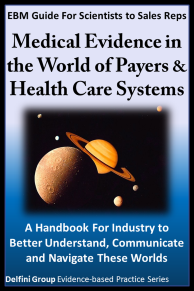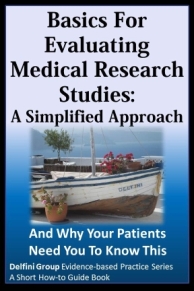EBM Guide For Scientists to Sales Reps
Medical Evidence in the
World of Payers & Health Care Systems:
A Handbook For Industry to
Better Understand, Communicate and Navigate These Worlds
Chapter 1. Why You Want to Read This Book: Bridge Building

If men can be said to be from Mars and women from Venus, then it is at least as fair to say that those working in health care systems or companies that provide coverage for health care and those working in the drug and medical technology manufacturing industries often relate to each other as if they come from different planets—which, indeed, they do. We've written this book to help those working in industry bridge these planets and foster a good relationship with both health care systems and payers using medical research to help establish meaningful common ground and a common language, with the ultimate goal of best serving patients.
We come from the payer- and health care systems-planet, but on the provider side. Typically, in our world, physicians and pharmacists who leave to work in industry are jokingly (or not so jokingly) said to have gone over to the "dark side." Imagine our surprise then, when teaching a group of industry scientists, analysts and account directors, one of them told us that for a while he left pharma to go work on the dark side. "Which would be where?" we asked in puzzlement, thinking we had misheard. All the workshop attendees started laughing at our confusion. "Well, on the payer side, of course," he answered, laughing himself.
And so we have a situation in which key players who have a major impact on health care decision-making, and ultimately on health outcomes, view each other in drastically opposing—and not very complimentary—terms. This can't be good for patients. And worse, much of the opposition—and confusion—centers on medical research, which we will interchangeably refer to as evidence or medical science, and which is where, as medical information scientists, evidologists and clinical improvement experts, we spend much of our lives.
The overarching mission of this book is to better serve patients. And patients will be best served when everyone engaged in their care is focused on their benefit: this includes manufacturers, providers of care and payers of that care. To help advance our mission of serving patients, our goal for this book is to help those working in industry better understand medical decision-making and the use (and sometimes misuse or nonuse) of scientific evidence by payer and health care systems to support or reject the coverage or benefit determination of a therapeutic intervention.
Unless they are unified under one company (and sometimes, even when they are), health care systems and payers are very different entities—but when it comes to medical evidence, there are big similarities. Each necessarily has to be cognizant of a population view and many of these organizations have their own pharmacy and therapeutics (P&T) and medical technology assessment (MTA) committees. For purposes of this book, the information we provide here is useful in working with each group. For simplicity's sake, frequently we will just use the term "customer" to refer to payers or health care systems unless we have something unique to say about one or the other. And while the focus of this book is on the microcosms of the health care systems and payer worlds, much of the information here, including tips, may be relevant at times to any medical decision-maker, including the prescribing physician or any other health care professional engaged in some way in medical decision-making.
To achieve our goal, our objectives for this book are to help bridge the world of manufacturers and the world of payer and health systems customers by helping industry to—
- Better understand health care systems, payers and other customers with a focus on their varying approaches to medical research;
- Be aware of typical confusions and misunderstandings by customers about medical science;
- Be attuned to typical research design, performance and reporting gaps that may hurt acceptance of your products—and what you can do to remedy this;
- Develop greater common ground and a common language to employ with customers in discussions about the medical evidence; and,
- Effectively harness the power of medical evidence to connect and communicate with customers.
This book is about helping you navigate the world of your customers whether they are sophisticated about medical research or not.
This book is written for anyone and everyone working in industry who is involved in—
- Generating or communicating about research; and,
- Any one of you who may face a research comment or question coming from a customer or who may be instrumental in facilitating such a discussion.
That means that this book is written for scientists as well as those in contracting or sales and everyone else in between such as product teams, scientific liaison staff, medical communications staff, etc. We will explain why this book is useful for those of you who generate and report on research, but let us start first with those of you who directly interact with customers. Many of you think of "communicating about the science" as being the responsibility of scientists and medical science liaisons. But the more you know about some essential basics about discerning the quality and clinical usefulness of research may help you better do your job. For example, consider this—
To Those In First-line Communications With Customers: A Scenario for You
The more you understand about an evidence-based approach, the more skilled you will be at working with your customers, and you may become the pivotal point for a yes or no coverage decision or a decision to keep your product's placement on a drug or technology formulary.
An evidence-based approach employs critical appraisal which, for our purposes, means evaluating medical research for its likely reliability and its clinical usefulness. Importantly, understanding basic elements of critical appraisal is not hard, and you can understand a lot about study results by simply understanding a few easy-to-understand statistics which utilize extremely simple mathematical formulas. The point of this book is not to teach you critical appraisal (and you do not need that knowledge for this book to be useful to you); but an objective of this book is, in part, to encourage you to gain basic critical appraisal knowledge. We are known for our simplified approach to understanding critical appraisal concepts, and we will give you choices of resources to help you.
The more you understand about critical appraisal, the more skilled you will be at determining the critical appraisal ability of your customers, understanding their evidence-based philosophy and evaluating what they are, or are not, putting into practice. This will potentially increase the success of your discussions with customers, which can make a crucial difference in a review or contracting decision.
Let us start by imagining a scenario in which you are representing a new drug on the market that high quality studies have shown to be highly efficacious and for which only a few minor side effects have been reported. The new product, however, is priced higher than the longstanding alternative. You are talking to a pharmacy director, and he tells you that his team has just completed a review of your new agent and various alternatives. He challenges you. Why, he asks, should they use your drug when the number-needed-to-treat reported in your competitor’s studies is smaller? Their agent will help more people, according to their research, yet your agent costs more.
This might be a make-or-break moment for your company. Your hope is that he will let you arrange for an appointment with your scientific team. But merely offering a meeting with your team could—at best—delay a change in perception about your agent and—at worst—could close the door, resulting in "end-of discussion."
Your best option is to give the director a response that keeps the door open for discussion. And how do you do that? Because he has issued you a critical appraisal challenge, the best option is to answer him using a critical appraisal response.
Number-needed-to-treat—or NNT—means the number of people that need to be treated within a certain period of time for one patient to experience a benefit over the compared alternative. On the surface, the lower the number, the better. However, if you have a sufficient understanding of critical appraisal, you know that there can be many reasons why an NNT could be smaller other than your competitor's product being more effective than your agent. Knowing this, you have a greater chance to address what may be an incorrect conclusion on the part of the pharmacy director. You also increase chances for further engagement and a changed position on your agent.
Your response could go something like this:
"I’m sure you know there are a lot of reasons why the number-needed-to-treat could be ‘reported’ as being smaller, but the actual truth of effect could be very different.
- I’m sure you know that bias tends to favor the intervention being studied which can make a reported NNT falsely small.
- It could be explained by heterogeneity in the studies such as a difference in study populations, study methods or in patient experiences or other differences.
- It could be a chance effect.
- Depending upon how it was derived, there could be issues with calculation methods.
"There are ways to look closely at all these areas, and I would be happy to arrange for one of our medical science liaisons to meet with you to discuss the studies you've reviewed and look into it more deeply."
Or you might be in a situation in which your customer knows relatively little about what constitutes a high quality study. If the science behind your product is strong and the science behind your competitor's product is poor, you have an opportunity. For example, care may have been taken to conceal patient assignment to their study groups in your study and no such measures were taken in your competitor's studies. You might say, "Research has shown that weaknesses in studies can falsely inflate results—sometimes even making results appear to be favorable when, in fact, they aren't. I would be happy to bring someone in to talk about our science and explain very transparently how our methods protect our studies from bias. For example, for blinding to be successful, it's important to make sure that no one is able to know or affect which study group a patient gets assigned to. I would be very happy to bring in one of our scientific staff members to talk with you about this."
Frequently, you get only one shot. In this book, we will give you some tips for how you can use some basic understandings about these types of customers and about medical evidence to help keep the door open. The more you understand about critical appraisal of the medical literature—regardless of your specific role—the greater an asset you are to your company.
This is true whether you directly communicate anything you learn about critical appraisal or just listen with a knowing ear. You may be the reason that a decision turns in your company’s favor when good evidence and good reporting support the superior value of your products.
While this book is not intended to teach you critical appraisal, we will address selected critical appraisal concepts as they pertain to general problems with study quality and reporting or typical misunderstandings on the part of many customers.
And, importantly, even if this is very new to you, don't worry! Again, the good news is that it is not difficult to acquire a basic understanding of the general elements needed for critical appraisal. Much of the time, a general understanding of bias and chance may be sufficient to evaluate whether or not an interventional research study is likely to be reliable and clinically useful. Frequently, the key to understanding the reliability of a study is not about statistics, but is about study design, methodology, execution and study performance outcomes such as whether or not blinding was successful. Armed with basic critical appraisal knowledge, you may understand your customer better, you can participate in discussions more flexibly and helpfully, you may hear something important to pass along to others on your team, and potentially you may do a world of good.
To Those Generating and Reporting Medical Research
Why will this book be helpful to you? You may be among the best researchers in the world, and yet much in this book has been written to benefit you.
Many of you think of the Food and Drug Administration (FDA) as your customer, neglecting to view payers or health care systems as your customers too. If you count yourself among these kinds of scientists, you may be missing some important opportunities that may help patients and, worse, your good work may be rejected due to misunderstandings by these customers or because key information that they need is not available to them.
We have worked with many industry scientists who are shocked when they learn how many of their studies might fail a critical appraisal and be rejected by customers. Frequently scientists are insulated from these end-users and, as such, are often not aware of what users are looking for to help them in their medical decision-making. In this book, we describe in detail elements for successful reporting, and we also discuss design elements and study methods that are frequently cited as being of import to customers.
We also provide you with "evidence about the evidence" to support our claims and observations about what we consider to be an unfortunate medical misinformation mess that you can be instrumental in helping to solve.
Also, many of you will become involved in directly communicating about your science to customers at some point. We help you understand some typical pitfalls and some common misunderstandings they may have, and we will give you helpful tips to navigate the world of these customers which differs in many ways from your own.
To All
An important truth to keep in mind as you read this book is that we are all rooting for reliable and useful science. A chief problem is that many of your customers don't know how to tell what that is. Another chief problem is that many of you aren't providing the right information for those who do.
~ End of Sample ~
Return to About This Book
Also available if you want to know more about critical appraisal:



